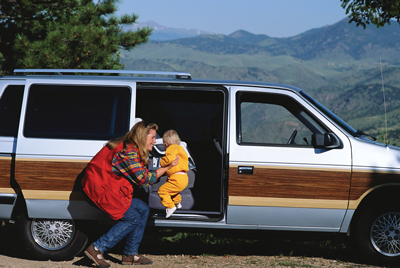BECOMING CAR SEAT SAVVY
Before road tripping with your children, ask yourself these three questions to determine whether your child is properly secured in a car seat.
by Joseph D. Younger

For Marc Cohen, the frustrations with child safety seats began when his first son was born. The AAA New York member dutifully had done his research and bought a seat that exceeded federal safety standards. He’d learned about the safest place to put it—the center of the backseat, farthest from crash forces in a side impact. And he’d learned about LATCH (an acronym for Lower Anchors and Tethers for Children), a system that was mandated by the federal government in 2002 and designed to make seat installation easier and supposedly foolproof.
But when Cohen tried to install his son’s car seat in his Jeep Cherokee he found that it had LATCH attachments only in the rear outboard positions. So he faced a dilemma: Should he use the recommended anchors in the right or left seat, places he knew to be less safe? Or should he ignore LATCH and belt the seat into the center position? “I spent hours—hours— researching this, and I found that there were still all these gray areas,” says Cohen.
A lot of parents seem to share Cohen’s confusion. According to studies, nearly three out of every four seats show an obvious mistake in selection or installation that could compromise a child’s safety. Before you take your child on your summer travels— or even to the supermarket—get good answers to these three questions.
Do you have the right safety seat for your kid?
“We see a lot of cases of inappropriate selection of seats for the child’s age and weight,” says Wes Bender, a certified child passenger safety instructor with Safe Kids USA. “That goes from moving infants into forward facing seats too soon, to putting older kids into booster seats before they’re ready and all the way to moving bigger kids into adult lap-and-shoulder belts too early.”
Pediatricians and safety experts recommend that infants remain in rear facing safety seats as long as possible—at least until they reach one year old and 20 pounds. Some babies reach 20 pounds long before their first birthdays, and parents want to move them into a forward facing seat for a variety of reasons. But, despite the babies’ size, their necks don’t develop sufficiently for a forward facing seat until at least they reach their first birthday.
Similarly, children should ride in a forward facing seat until they reach the seat’s weight limit (as specified by the manufacturer), their ears reach the top of the seatback or their shoulders go above the topmost harness slots. And older kids should use a booster seat until they can meet three tests:
- their knees bend comfortably at a 90 degree angle at the edge of the seat when they sit up straight with their spine flush against the seatback;
- the vehicle’s shoulder belt passes across their chest, not their throat; and
- the lap belt fits across their hips not their tummy or abdomen.
That means about 4 feet, 9 inches tall in most vehicles. Although New York State law says that kids must stay in a booster seat until they reach age 6 or stand over 57 inches or weigh 100 pounds, the vast majority of children shouldn’t go boosterless until age 10 or 11. For more advice, consult the American Academy of Pediatrics’ guide at www.aap.org/family/carseatguide.htm.
Does the harness fit the child?
“We see a lot of harnesses that aren’t snug on the child,” says Bender. “The harness should pass the ‘pinch test.’ If you pinch the strap lengthwise and get any size of a loop between your thumb and finger, then it’s not tight enough. If you start securing kids snugly at an early age, they won’t feel uncomfortable.”
Have you installed the seat properly?
Designed as an alternative to safety belts for securing child safety seats, LATCH hasn’t ended parents’ confusion about installation. At least some of them, like Cohen, worry about not having LATCH attachments in the center rear position of their vehicles. In fact, most vehicles don’t have them there because the government mandated that every vehicle must have LATCH attachments for two safety seats. For most models, carmakers could fit two LATCH systems in the back seat only by putting them in the outboard positions.
“We still recommend the center-rear position as the safest place if you have only one child and the seat fits well,” says Cheryl Kim of SafetyBeltSafe USA. “Basically, you should use whichever method gives you the tightest fit or whichever is easier for you to use.”
Some parents use a jury rigged LATCH installation for the center position, using the inner anchors from each side. Unfortunately, on most vehicles, that could compromise the child’s safety in a crash. Experts advise resorting to that method only if both the safety seat manufacturer and the carmaker approve. Whether you use LATCH or the safety belts, you can find safe installation tips at SafetyBelt-Safe USA’s Website (www.carseat.org).
If you’re still not sure, have the seat checked by a certified child passenger safety technician. (For locations near you, go to www.seatcheck.org or call 866/SEAT-CHECK. Most checkup locations schedule appointments weeks in advance.) That’s what Cohen did, and a technician at St. Mary’s Children’s Hospital in Bayside took almost an hour explaining the intricacies of proper installation to him. Now, he sleeps better at night for it, knowing that his kids will ride safely along with him. For Club members, AAA New York has scheduled the following safety seat checkups:
- July 12, 2008, 11 a.m.–3 p.m., Wal-Mart, Consumer Square, 4765 Commercial Dr., New Hartford
- July 26, 2008 10 a.m.–2 p.m., Bronx Safety City, 837 Brush Ave., Bronx
For more information, call 516/873-2364 or visit www.AAA.com/Safety. Also, click here to learn about the Club’s safety seat loan program for members with youngsters visiting from out of state.

© 2015 TLC Magazine Online, Inc. |